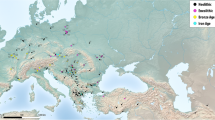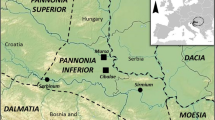Abstract
Archaeobotanical finds in Spain show differences in the representation of the different wheats and barleys. From the beginning of agriculture (around 5000 B.C.) onwards, all wheats and barleys can be found at the sites of the eastern Peninsula. But in later periods of the early Neolithic, free-threshing wheat becomes more important in the northeast and the southeast, compared to the hulled wheats (emmer and einkorn). Nevertheless, both naked and hulled barleys can be found in similar frequencies in this period. Seed analyses in the southeast and the east of Spain show the importance of naked barley compared with hulled barley in the third millenium uncal B.C. This is not the case in the northeast, where hulled barley has a similar frequency in this period until the Iron Age, when both hulled barley and free-threshing wheat are the most important taxa. The substitution of naked barley for hulled barley in the south-east Iberian Peninsula is very significant in the period of greatest growth of the Argar culture. Free-threshing wheat can be found at a similar frequency throughout the study area, and was an important human food source together with the barleys. Hulled wheats seem to have played a secondary role as food in all periods, although they are constantly present in our samples. Nevertheless spelt wheat does not appear until the Roman period, when it is only found on the Cantabrian north coast, where it is important.
Similar content being viewed by others
References
Alonso N (1992) Paleoeconomia i Paleocologia a la Plana Occidental Catalana durant la Protohistória. Aportacions de l'Arqueobotànica (Navors i fruits). Llicenciatura Thesis. Universitat de Lleida
Alonso N, Buxó i Capdevila R (1991) Estudis sobre restes paleocarpològiques al Vallès Occidental: primers resultats del jaciment de les Sitges UAB (Cerdanyola del Vallès). Limes 1: 19–35
Alonso N, Buxó i Capdevila R (1995) Agricultura, alimentación y entorno vegetal en la Cova de Punta Farisa (Fraga, Huesca) durante el Bronce Medio. Espai/Temps 23, Lleida
Alonso N, Garcés I, Junyent E, Lafuente A, López J, Miró JM, Ros M, Rovira C (1996) Aproximació a l'estudi del territori de Els Vilars (Arbeca, Les Garrigues) i la seva explotació. Gal.la 3, St. Feliu de Codines, in press
Burillo F (1983) El poblado de época ibérica y yacimiento medieval: Los Castellares (Herrera die los Navarros, Zaragoza). Institución Fernando et Católico 1, Zaragoza, 105–106
Buxó i Capdevila R (1989) Estudi de les restes carbonitzades de la Cova de la Recambra. Cypsela 7: 11–20
Buxó i Capdevila R (1990) Metodologia y técnicas para la recuperación de restos vegetales (en especial referencia a semillas y frutos) en yacimientos arqueológicos. Cahier Noir 5. Girona
Buxó i Capdevila R (1993) Des semences et des fruits. Cueillette et Agriculture en France et en Espagne Méditerranéenne du Neolithique à l'Age du Fer. Doctoral Thesis (unpublished), Université de Montpellier
Buxó i Capdevila R, Catala M, Villalba MJ (1992) Llavors i fruits en un conjunt funerari situat en la galeria d'accès a la Mina 28 de Can Tintorer (Gavà). Cypsela 9: 65–72
Cubero C (1990) Análisis paleocarpológico de muestras del Alto de la Cruz. In: Maluquer J, Gracia F, Munilla G (eds) Alto de la Cruz (Cortes de Navarra). Dip. Provincial de Navarra, 200–214
Cubero C (1991) Estudi de les Illvors trobades a la sitja II del Vilar del Met (Vilanova del Camí). Estrat 4: 34–36
Cubero C (1993a) Aproximación al mundo agrícola de la I Edad del Hierro a través del estudio de semillas y frutos: El Torrello de Almassora (Castelló). In: Fumanal MP, Bernabeu J (eds) Estudios sobre et Cuatemario. Valencia, 267–273
Cubero, C (1993b) Estudio de las muestras carpológicas del yacimiento de Cancho Roano (Zalamea de la Serena). In: Celestino S, Jiménez FJ, El Palacio-Santuario de Cancho Roano IV, El sector norte. Badajoz, 215–221
Cubero C (1994) La Agricultura en la Edad de Hierro en el nornoreste de la Peninsula Ibérica a partir del análisis paleocarpológico. Doctoral Thesis, (unpublished), Universitat de Barcelona
Chamorro JG (1991) Campaña de flotación en et Castillo de Dña. Blanca (Pto. Sta. Ma., Cádiz). Método, muestreo y resultados. Arqueologia Medioambiental a través de los macrorestos vegetales, Madrid, 1–18
Erroux J (1976) Les débuts de l'agriculture en France: les céréales. In: Guilaine J (ed) La Préhistoire Française, II. Civilisations néolithiques et protohistoriques, CNRS, Paris, 186–191
Hillman GC (1978) On the origins of domestic rye — Secale cereale: the finds from aceramic Can Hasan III in Turkey. Anatolian Stud 28: 157–174
Hopf M (1964) Getreidefunde von El Cigarralejo bei Mula (Murcia). Madrider Mitt 5: 157–166
Hopf M (1966) Triticum monococcum y Triticum dicoccum Sch en et neolitico antiguo español. Archiv Prehist Levantina 11: 53–80
Hopf M (1971) Vorgeschichtliche Pflanzenreste aus Ostspanien. Madrider Mitt 12: 101–114
Hopf M (1972) Vegetales prehistóricos de la comasca de Requena (Valencia). Archiv Prehist Levantina 13: 51–55
Hopf M (1974) Neolithische Pflanzenreste ans der Höhle Los Murciélagos bei Zuheros, Córdoba. Madrider Mitt 15: 9–27
Hopf M (1987) Les débuts de l'Agriculture et de la diffusion des plantes cultivées dans la Péninsule Ibérique. In Guilaine J, Barbaza M, Geddes M, Vernet JL (eds) Premières communautés paysannes en Mediterranée occidentale. Actes du Colloque du CNRS. CNRS, Paris, pp 267–274
Hopf M (1991) South and Southwest Europe. In: Zeist W van, Wasylikowa K, Behre KE (eds) Progress in Old World Palaeoethnobotany. Balkema, Rotterdam, pp 241–277
Jacomet S, Schlichtherle H (1984) Der Kleine Pfahlbauweizen Oswald Heer's. Neue Untersuchungen zur Morphologie neolithischer Nacktweizenähren (Oswald Heer's small lake dwelling wheat. New investigations on the morphology of Neolithic wheat ears). In: Zeist W van, Casparie WA (eds), Plants and Ancient Man, Balkema, Rotterdam, pp 153–176
López P (1980) Estudio de semillas prehistóricas en algunos yacimientos españoles. Trabajos Prehist 33–34: 419–439
Marinval P (1988) L'alimentation végétale en France. CNRS, Paris
Peña Chocarro L (1995) Avance preliminar sobre los restos vegetales del yacimiento de la Edad del Bronce de Peñalosa (Baños de la Encina, Jaén). Actas Trabalhos Antropol Etnol 35(1), 159–167
Rodríguez O (1992) Human-plant relationships during the Copper and Bronze Ages in the Baza and Guadix basins (Granada, Spain). In Vernet JL (ed.) Les Charbons de Bois, les anciens écosystemes et le rôle de l'Homme. Bull Soc Bot France 139, Actual Bot (2/3/4): 451–464
Schiemann E (1948) Weizen, Roggen, Gerste. Systematik, Geschichte and Verwendung. Fischer, Jena.
Stika HP (1988) Botanische Untersuchungen in der bronzezeitlichen Höhensiedlung Fuente Alamo. Madrider Mitt 29: 21–76
Tellez R, Ciferri F (1954) Trigos arqueológicos de España, INIA, Mo. de Agricultura, Madrid
Vernet JL, Badal E, Grau E (1983) La végétation néolithique du sud-est de l'Espagne (Valencia, Alicante) d'après l'analyse anthracologique. C R Acad Sci Paris 296(3): 669–672
Zeist W van (1976) On macroscopic traces of food plants in southwestern Asia (with some reference to pollen data). Phil Trans R Soc Lond B 275: 27–41
Zeist W van (1980) Aperçu sur la diffusion des végétaux cultivés dans la région méditerranéenne. Colloque de la Fondation L. Emberger, La mise en place, l'évaluation et la caractérisation de la flore et de la végétation circum-méditerranéenne. Naturalia Monspeliensia Hors Série, Montpellier, pp 129–145
Zohary D, Hopf M (1994) Domestication of plants in the Old World, 2nd edn, Clarendon, Oxford
Author information
Authors and Affiliations
Rights and permissions
About this article
Cite this article
Buxó i Capdevila, R., Alonso, N., Canal, D. et al. Archaeobotanical remains of hulled and naked cereals in the Iberian Peninsula. Veget Hist Archaebot 6, 15–23 (1997). https://doi.org/10.1007/BF01145882
Received:
Accepted:
Issue Date:
DOI: https://doi.org/10.1007/BF01145882




